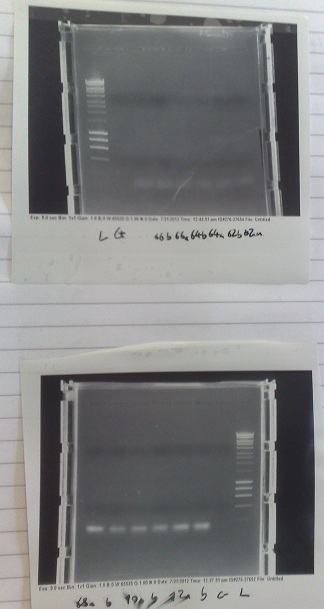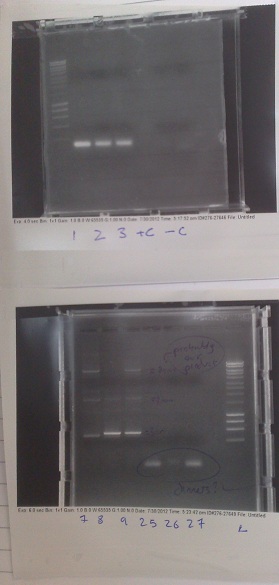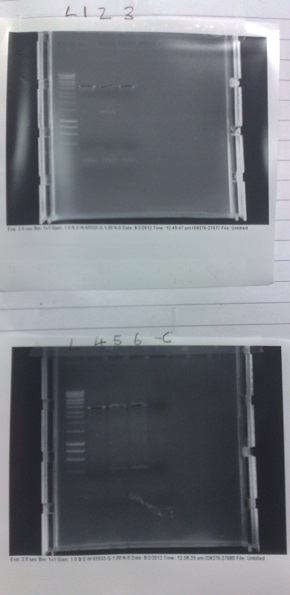Team:Cambridge/Lab book/Week 6
From 2012.igem.org
| Week: | 3 | 4 | 5 | 6 | 7 |
|---|
Contents |
Monday
- Not all products were obtained during Friday's PCR. Most of these missing products were large vector backbones. They are being run again, with a much longer extension time of 300s. If that fails, primers will be ordered to split the vectors into manageable chunks, and the PCR reattempted when they arrive.
- PCR cycle x35:
- 15s Denaturing at 95 C
- 45s Annealing at 60 C
- 300s Extension at 72 C
- Remaining stray product had a slightly tricky secondary structure at the 3' end. It will be run at a series of annealing temperatures in a PCR machine capable of a temperature gradient.
- mOrange PCR run at many different temperatures, from 62 °C to 76 °C. Hopefully this should resolve the difficulties we have been having.
Separation of vector and mOrange DNA
- Positive control produced no band. No primer smear - primers may not be in mix for some reason.
- Realized correct lux vector template was not added during PCR preparation, consequently no amplification occured. Still appears to be a primer smear.
- Fluorescent construct produced several bands. Appears to be due to mis-priming during PCR. Either changing the primers or raising the annealing temperature should solve this problem, but may mean that we have to do this PCR separately.
- Riboswitch vector also failed. However, the extraction from the previous PCR run may have worked. We will try producing a functional plasmid with this extraction before running this PCR again.
Construction of riboswitch plasmid with Gibson Assembly
- DNA from lanes 27+28, 27+29, 27+30 from gels run on Friday fused together with Gibson assembly to produce riboswitch construct. This does not have replacement of the first 8 codons of lac I with the 8 codons native to the gene downstream of the riboswitch.
- DNA from lanes 22,23 and 24 fused with riboswitch DNA produced two weeks ago to produce riboswitch construct. This has replacement of the first 8 codons of lac I with the 8 codons native to the gene downstream of the riboswitch.
Transformation of Bacillus with riboswitch construct
- Plasmids made by Gibson transformed into bacillus cells made two weeks ago and transformants plated out on 5μg/ml chloramphenicol plates.
Tuesday
New biobricks
- E.coli containing biobricks ordered were plated out on kanomycin plates (50μg/ml).
Transformation of Bacillus with riboswitch construct
- Plasmids made by Gibson transformed into bacillus cells made two weeks ago and transformants plated out on 5μg/ml chloramphenicol plates.
Transformation of E.coli with riboswitch construct
- Plasmids made by Gibson transformed into TOP10 e.coli cells and transformants plated out on 100μg/ml ampicillin plates.
Wednesday
Mg2+ Riboswitch
- Successful colonies produced from transformations two days ago streaked out onto chloramphenicol (5 μg/ml) containing plates.
- Colonies also grown up in 10ml of medium A for use with plate reader later.
Thursday
PCR of split fluorescent construct
- Our present theory is that the vectors that we are trying to amplify is too large for the PCR to effectively take place. Given this, we are using split primers to try to reduce the size of the fragments (kindly provided by P.J.Steiner).
- New primer sequences:
- Forward: tgaagtgttcgacaatataaatgtg|CGAAACGATCCTCATCCTGT
- Reverse: ACAGGATGAGGATCGTTTCG|cacatttatattgtcgaacacttca
- After gel electrophorsis, it was found that the PCR had worked perfectly. Given we now have all the fragments for the fluorescent construct, we will try to make it with Gibson ASAP.
Friday
Construction of fluorescent plasmid with Gibson Assembly
- Isothermal reaction buffer *5 remade with correct composition. Needed to order NAD+, so used some master mix from Haseloff lab.
- Various Gibson tail tagged DNA fragments produced over last few weeks assembled together using Gibson protocol:
- pJS130 plasmid fragment A
- pJS130 plasmid fragment B
- CFP (E0020)
- Terminator (B0015)
- pVEG + RBS (K143053)
- YFP (E0030)
Transformation of TOP10 e.coli with Gibson products
- 3 tubes of TOP10 transformed with Gibson products. Cells plated out on 100μg/ml ampicillin plates.
- No positive control added. If no cells grow, will add positive control to all future experiments.
- PCR of magnesium riboswitch vector repeated with primers to split plasmid.
- Lanes 2 + 3: Fragment A (center - cut site (promotor side))
- Lanes 4 + 5: Fragment B (without 8 codon substitution) (cut site (lac I side) - center)
- Lanes 6 + 7: Fragment B (with 8 codon substitution) (cut stie (lac I side) - center)
- Gels run, found PCR was unsuccessful.
 "
"




